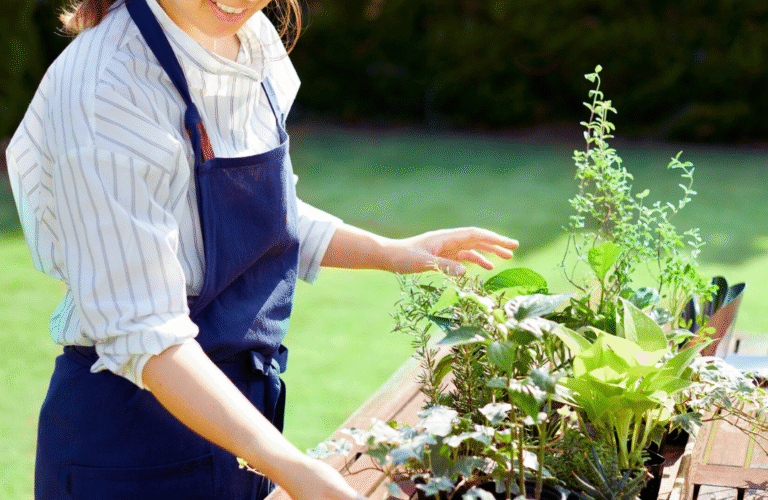A well-stocked kitchen often includes various herbs that can elevate everyday meals and encourage healthy cooking. Five essential herbs that every home should have are basil, parsley, rosemary, thyme, and coriander, each bringing unique flavours and health benefits to a variety of dishes. These herbs are not only easy to grow in a small herb garden, but they also enhance the taste of both simple and complex recipes alike.
Basil adds a sweet, aromatic touch to sauces and salads, while parsley brings a bright freshness to any dish. Rosemary and thyme offer robust flavours, ideal for roasting meats or vegetables. Coriander, with its distinctive taste, can transform salsas and soups. By incorporating these herbs into daily cooking, one can enjoy a richer culinary experience and promote overall wellness.
Essential Herbs Every Home Should Have
Incorporating herbs into everyday cooking and home remedies adds flavour and health benefits. A selection of essential herbs can elevate dishes and provide versatility in various culinary practices.
Basil
Basil is often regarded as a cornerstone herb in many kitchens. Known for its sweet and slightly peppery flavour profile, it enhances dishes like pasta, salads, and pizzas. Fresh basil is particularly effective in recipes such as pesto, a blend of basil, pine nuts, garlic, and olive oil.
When using basil, it is best added at the end of cooking to preserve its essential oils and fresh taste. It can also be grown easily in pots indoors or outdoors, thriving in warm, sunny conditions. Regular harvesting encourages bushier growth, ensuring a plentiful supply for culinary use.
Thyme
Thyme’s earthy and slightly minty flavour profile makes it a versatile addition to any spice rack. This hardy herb pairs beautifully with meats, stews, and roasted vegetables. Fresh thyme is a favourite among chefs and home cooks alike.
Incorporating thyme into dishes is simple; it can be used whole or stripped from the stem. Dried thyme also offers convenience without sacrificing too much flavour. As a hardy perennial, thyme can grow in various conditions, thriving in well-drained soil with moderate sunlight, making it suitable for many gardens.
Rosemary
Rosemary boasts a strong, aromatic profile that pairs well with robust meats such as lamb and salmon. Its distinct flavour can transform dishes, bringing depth and fragrance. Fresh rosemary can also infuse oils and vinegars for salad dressings.
This herb prefers well-drained soil and plenty of sunlight, making it easy to cultivate in gardens or pots. Additionally, rosemary is known for its essential oils, which can be extracted for use in aromatherapy. Regular pruning encourages growth and prevents the plant from becoming too woody.
Mint
Mint is a refreshing herb that enhances both savoury and sweet dishes. Its cool, crisp flavour is perfect for cocktails, dressings, and desserts. Peppermint and spearmint are common varieties, each offering a unique taste profile.
Mint grows vigorously and can be cultivated in gardens or containers to prevent it from overtaking other plants. It thrives in moist soil and partial shade, making it versatile in gardening setups. Fresh mint leaves can be muddled into beverages or used to garnish plates, adding not only flavour but also visual appeal.
How to Grow and Care for Common Culinary Herbs
Growing culinary herbs at home provides fresh flavours and enhances various dishes. Proper care and cultivation techniques are necessary for a thriving herb garden, whether indoors or outdoors.
Starting an Indoor Herb Garden
To begin an indoor herb garden, select pots that are at least 15 cm deep with drainage holes. Use a high-quality potting mix to ensure proper aeration. Suitable herbs for indoor growth include basil, parsley, and thyme.
Place the pots in a location receiving at least 6 hours of sunlight each day. If natural light is insufficient, consider using grow lights. Regularly water the herbs, allowing the soil to dry slightly between watering to prevent root rot. Feeding with a diluted liquid fertiliser every four weeks encourages healthy growth.
Outdoor Herb Cultivation Tips
For outdoor herb cultivation, choose a sunny spot in the garden that receives full sunlight for at least 6-8 hours daily. Ensure the soil is well-draining and rich in organic matter. Amend the soil with compost for optimal nutrient levels.
Spacing is crucial; plant herbs like rosemary and oregano at least 30 cm apart to allow for air circulation. Regular weeding and mulching help retain moisture and suppress weeds. Herbs should be watered regularly during dry spells, focusing on the soil rather than the foliage to prevent fungal diseases.
Harvesting and Storage Techniques
Harvesting herbs can be done when they reach about 15 cm in height. Use clean scissors to snip off leaves or stems, focusing on the outer parts to encourage growth. Herbs should be harvested in the morning, when oils are most concentrated.
For storage, fresh herbs can be placed in water-filled jars in the refrigerator or wrapped in damp paper towels. For longer preservation, consider drying the herbs. Hang them upside down in a dark, dry place or use a dehydrator. Dried herbs should be stored in airtight containers away from light to maintain flavour and potency.
Culinary and Medicinal Uses for Essential Herbs
Herbs are versatile ingredients in both culinary and medicinal contexts. Their unique flavours enhance dishes while providing potential health benefits. This section highlights how essential herbs can elevate daily meals and serve as natural remedies.
Adding Flavour to Everyday Dishes
Fresh herbs significantly influence the flavour profile of various dishes. Basil, with its sweet and slightly peppery taste, pairs well with tomatoes in salads or as a topping for salmon. Rosemary adds depth to roasted vegetables or meats, enhancing savoury dishes with its woody aroma.
Mint and peppermint bring refreshing notes to drinks and desserts. They can quickly transform a simple lemonade into a revitalising beverage or elevate fruit salads with their cool flavour. Lavender, though less common, adds floral notes to baked goods and can be infused in syrups, providing a unique twist.
Using herbs regularly helps enhance dishes without additional salt or sugar, making meals not only tastier but also healthier.
Making Fresh Herb Infusions and Cocktails
Herbs can create delightful infusions and cocktails. Lemon balm is a popular choice for a light, citrusy infusion, perfect for teas or refreshing summer drinks. A quick infusion can be made by steeping fresh leaves in hot water, offering a calming effect.
For cocktails, mixing mint or basil with spirits like gin or rum can produce unique flavours. Muddling these herbs releases their essential oils, giving the drink an aromatic profile. A classic mojito blends mint with lime, sugar, and rum, delivering a refreshing beverage ideal for warm days.
Experimenting with different combinations allows for creativity in crafting both non-alcoholic beverages and cocktails.
Herbs in Traditional Remedies
Herbs have been used in traditional remedies for centuries, valued for their medicinal properties. Peppermint, known for its digestive benefits, can relieve indigestion and headaches. Its essential oils are often used in aromatherapy for their calming effects.
Lavender is renowned for promoting relaxation and sleep. Infused in teas or oils, it can soothe the mind and reduce anxiety. Similarly, rosemary is believed to improve memory and concentration, frequently used in teas and supplements.
These herbs not only flavour meals but also serve as natural options for supporting health and wellness. Understanding their uses can greatly enhance one’s culinary and medicinal experiences.




